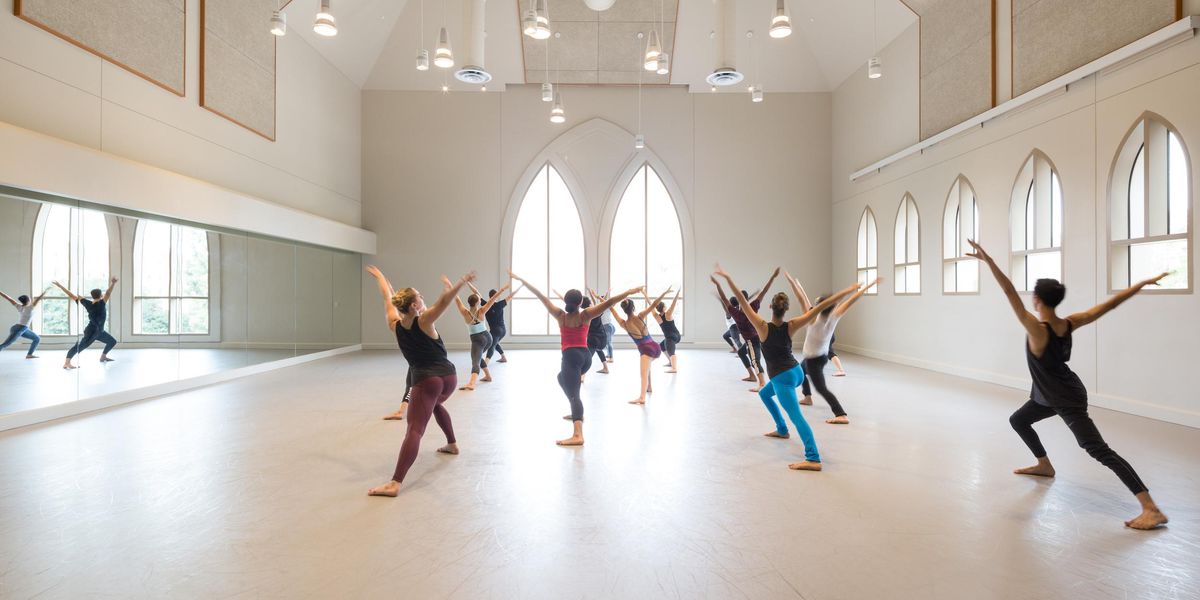Ballet as Springboard
Four dancers who left their classical careers behind
Jackie Carlson sprang from Dance Theatre of Harlem Ensemble to STREB. Photo by Joel Bischoff, Courtesy STREB.
springboard (noun): A strong, flexible board from which someone can jump in order to gain impetus or assistance.
For many professional dancers, ballet is the fundamentally strong and artistically flexible technique from which they can dive into new technical waters. Alex Wong, former Miami City Ballet principal soloist, used his pyrotechnic ballet skills to bounce onto Season 7 of So You Think You Can Dance. “I strive for the impossibility of ballet perfection,” says Wong, “but I love adapting to new styles and choreographers.” Switching careers is never easy—ballet dancers may need to find freedom in movement and become fearless risk takers in other performance styles.
The Stunt Double
Michigan native Jackie Carlson always dreamed of becoming a ballerina…or a stunt double! A well-rounded competition dancer, she spent five ballet-intensive summers at Milwaukee Ballet School and joined Dance Theatre of Harlem Ensemble in 2002.
Although she enjoyed the graceful aesthetic, she soon desired movement with more punch. “I hated being partnered,” she says. “I often would rather do what the guys did.” Occasionally she trekked to Chelsea Piers, sneaking in gymnastics classes to maintain acrobatic tricks.
When DTH went on hiatus in 2004, Carlson seriously investigated stunt double careers. Then she read a Dance Magazine article featuring STREB Extreme Action Company. Having never heard of the company (or been to Brooklyn) she ventured to their Williamsburg warehouse. “It was perfect for me. I couldn’t believe this type of company existed!” she says. Getting in, however, tested her determination.
Carlson started PopAction classes at STREB Lab for Action Mechanics (S.L.A.M.) in 2005. “The technique didn’t seem like dance at first. There are no mirrors, and we didn’t learn a routine to music, which I definitely missed.” After two years of taking class and two audition rejections, she got an offer from the company.
While jumping off high platforms or dodging cinder blocks can be frightening, Carlson feared improvisation even more. “Every day I face a new fear, something I don’t think I can do, but then I feel so alive when I prove I can do it.” Her upper body grew stronger and changed dramatically. “Ballet had a lot of pressure to be skinny, and now my arms in fifth position look like a body builder,” says Carlson. “But I feel more confident as a person.” There is no going back for Carlson, but she finds ways to infuse grace, flair, and ballet lines into her work with STREB.
A Modern Ballerina
West Coaster Vanessa Thiessen never questioned her career path; by age 10 she knew she would be a ballerina. From 1995 to 2003 she performed with Oregon Ballet Theatre, then during the next five years with Smuin Ballet. “Ballet to me is the most challenging technique,” Thiessen says. “I like the focus on perfection—crossing your fifth and making clean lines.” At only 5′ 1″, Thiessen enjoyed being lifted, flying around stage, and moving as expansively as the taller dancers.
Thiessen’s change of heart developed gradually. San Francisco’s vibrant dance scene provided new possibilities. She took class at LINES and ODC/San Francisco during company breaks to get out of pointe shoes and into unbounded movement. Despite two ODC audition rejections, Thiessen stuck around and joined the company in 2008.
Vanessa Thiessen rode from Oregon Ballet Theatre and Smuin Ballet to ODC/San Francisco, where she is, here, with Daniel Santos. Photo by Steve Maller, Courtesy ODC.
“The hardest part of transitioning was understanding their language for movement,” she says. “I couldn’t remember the steps. They are fast and complicated!” She was also terrified to contribute to the creative process, but soon realized there is no right or wrong in improvisation.
Physically Thiessen is more accepting of her body now than as a ballet dancer. “There was a time during the transition when I felt bulky and heavier, but it was only compared to my ballet body,” she says. “Our work is extremely physical and unpredictable, so I cross-train with rock climbing, hiking, and kayaking.”
Now in her fourth ODC season, Thiessen feels more grounded. “I don’t try to deny my ballet background—I’m very proud of it—I’m combining it with freedom and reality.”
What Happens in Vegas…
The bright lights of showbiz often draw dancers away from classical companies. For Lynorris Evans it was Cirque du Soleil. A 2006 Ailey/Fordham BFA graduate, Evans chose BalletMet Columbus to jump outside his contemporary zone. Like many male dancers, he was a relative latecomer to the ballet world.
“My challenge was getting comfortable with classical walks, miming, and finding my onstage presence,” Evans recalls. Though featured in contemporary roles, he believes he matured the most artistically through performing classical roles like the Nutcracker prince and the lead in Aladdin.
By his third season Evans was eager to experience more, and auditioned for Cirque. After two auditions and months of waiting, he was cast in Viva Elvis in Las Vegas. Joining a cast of 75, he performed 10 shows weekly for over two years.
“Doing the same show two times a night was a big adjustment,” says Evans. “I had to keep movement fresh and develop my acting. I was surrounded by talented singers, actors, and acrobats, so I constantly learned from everyone.” A variety of class styles was offered to cast members, including ballroom, hip hop, jazz, and ballet. This spring Evans is headed to Broadway, where he will combine his love of dancing and singing in the new production of Leap of Faith.
Lynorris Evans swung from BalletMet Columbus to Cirque to
Leap of Faith. Photo by Will Shively, Courtesy BalletMet.
The Showman
After becoming the first Canadian to win the Prix de Lausanne (2004), and dancing with American Ballet Theatre’s Studio Company and Miami City Ballet, Alex Wong’s commercial stardom encountered several speed bumps. His Achilles tendon snapped during SYTYCD, so he moved to New York to recover and signed with BLOC talent agency. Then at an audition for the movie Step Up 4, he ruptured his other Achilles tendon. During his recoveries he branched out into acting and singing. Wong recently made it to this season’s American Idol Hollywood round, released his first single on Amazon and iTunes, and is appearing on episodes of the new TV show Smash.
Wong’s biggest challenge during the career switch? “Finding a louder personality, being facially animated, and breaking from a strict demeanor.” Another big change is his unpredictable schedule. Wong is bicoastal, often flying between L.A. and New York—and sometimes other cities—never knowing exactly what his week holds.
Wong hits the gym harder for commercial work. “I like the way my body feels when I train classically,” he says. “It frees my body and allows me to do anything. But commercially I look better filled out.”
Like Evans, Wong plans to jump into Broadway this spring—in his case, he’ll be performing in Newsies.
Television, acrobatic stunts, modern dance, circus productions, and musicals—with a ballet foundation, an open mind and perseverance, no direction is out of reach.
Jen Peters is a dancer with Jennifer Muller/The Works, a Pilates instructor, and a frequent DM contributor.
Photo of Alex Wong, who leapt from Miami City Ballet to
So You Think You Can Dance to Newsies, by Cory Jones, Courtesy Wong.





